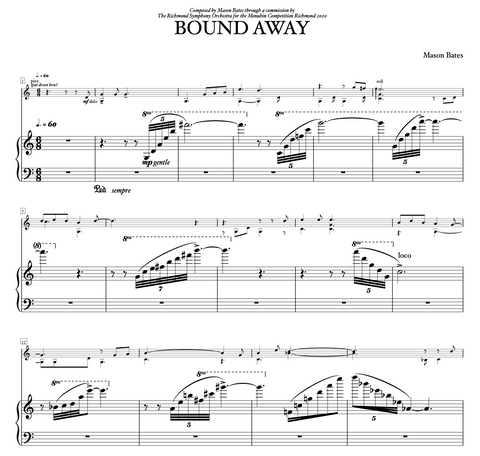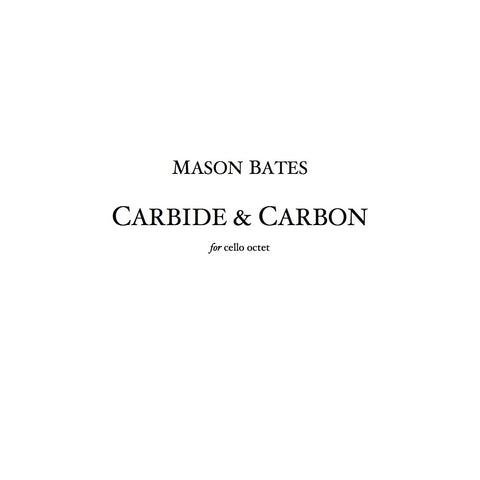Digital Loom
$ 50.00
for Organ & Electronica
Approximate Duration: 20'
Buy on iTunes: https://itunes.apple.com/us/album/mason-bates-digital-loom/id323320911
PROGRAM NOTES
Pairing an ancient instrument of the church with the sounds of modern-day dance music did not seem like a pregnant idea at first. It was the organ's ability to play loud enough to compete with any speaker system that initially was intriguing -indeed, the vibrations of the organ's lowest notes should give any subwoofer a run for its money - but that superficial advantage quickly paled in comparison to other rich possibilities. After all, it is the world's oldest synthesizer.
The power of the organ lies in its ability to create a space. Indeed the organist - like his modern-day club counterpart, the DJ - is simultaneously perceived as background accompaniment to various activities, and as the invisible hand controlling the choreography within its belly. Sometimes as I sat in the choir loft of my church school in Virginia, letting my mind wander during communion or a procession, I imagined the organ as an enormous yet almost invisible creature, whose miles of piping are entangled within and around the church's structure like a central nervous system. Congregational recitations of the Apostle's Creed, the ringing of bells on the roof, even our own singing - all of this must sound so hollow and distant from deep in the bowels of the organ. The mysterious ambience of a dusky church, with faint organ harmonies wafting up from the stone floor, inspired a pairing with the abstract beats of ambient electronica, and in this space Digital Loom begins.
This static world (dominated by one sonority) moves like continental drift, creating a powerful expectation that is soon disrupted by the quickening rate of change. The evolution, via the contagious beats of drum 'n bass, to a bright fanfare begins a more dynamic section, which ultimately boils over into an explosion of stratospheric sonorities. Only gradually do they fall lower, and in this surreal world we return to the opening sonority, where cross-fading chords recall the opening continental drift and environmental electronic sounds indicate that we are free of the tyranny of beats. All seems at peace, but the appearance of a colossus of a bassline, 'walked' by the organist's feet, takes us into a fiendish reincarnation of the fanfare theme, and on this note we end.
PERFORMANCE NOTES
ORGAN: Digital Loom works best on an organ with three manuals and two enclosed divisions, but an alternate version is available for organs with only one enclosed division. That version affects only the first and third movements (which feature slow cross-fades between two manuals), and it achieves an approximate effect by slowly adding and releasing notes. This gives the effect of chords growing and reducing in volume.
ELECTRONICS: The piece requires simply two stereo speakers, placed on the left and right sides of the stage, and a CD player for playback. A monitor placed near the organist will help the performer stay in precise tempo with the electronic part. Because the electronic part consists primarily of beats - and because the score is carefully cued when the electronics become more environmental - a click track is not needed. For reasons of balance and precision, someone situated in the hall near the CD player and volume control would be useful. A 'live' version of the electronic part can be realized when the composer is present, who performs the electronica part on an electronic drum pad and laptop. But it is entirely possible for the organist to perform the piece with no additional assistance : the CD player can sit near the organist. All of the track numbers are listed in the score, and the electronica part runs continuously.
REVIEW
Mason Bates’s “Digital Loom,” for organ and electronics … transformed the hall into something between a decaying cathedral and an East Berlin club."
—Alex Ross (The New Yorker)
"Take Mason Bates’s Digital Loom for organ and electronics, a centennial commission. Definitely a voice from the younger generation, Bates reimagines the king of instruments as a surreal creature inventing its own space, the illuminated stops flashing like an enormous pinball machine and presided over by the organist as D.J. who programs wild sequences of hip-hop, funk, and ambient electronica. —Peter Davis (New York Magazine)




